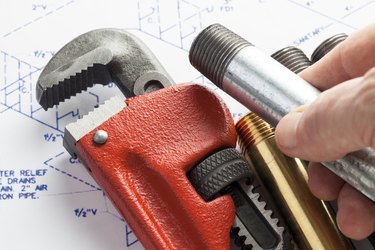
Pipe unions and couplings are both types of fittings that allow you to repair breaks in plumbing lines, but there's an important difference between them: A coupling makes a permanent connection, while a union makes one that can be separated and reassembled repeatedly.
Plumbing codes don't specify which fitting you should use in a particular situation, so the decision is up to you. Because it's easier to install, especially if you're working with plastic plumbing pipes, a coupling is generally the go-to choice, but a union is a better choice if you expect to have to disassemble the joint in the future for maintenance. Sometimes, when you're working with threaded pipe, a union offers the most practical way to make a repair.
Video of the Day
Video of the Day
Couplings and Unions: What Are They?
A pipe coupling is a straight fitting with inlets appropriate for the type of pipe for which you use it. A plastic or copper coupling usually has a slip joint that fits over the pipe and gets glued (plastic), soldered (copper), or held on by compression. The couplings for galvanized metal pipes and some plastic ones have female threads that screw onto the male threads on the ends of the pipes being joined. Once you install a coupling, the connection is permanent unless you use a compression coupling.
A union can have slip-joint or threaded ports like a coupling, but the big difference is a large central nut in the middle that unscrews to separate the fitting. This comes in handy in a number of situations, one of the most common being water heater connections. Installing unions on the water heater ports allows you to disconnect the water heater for repair or replacement without disturbing any of the plumbing.
How to Use a Pipe Coupling
If you're installing new plumbing, you generally join pipes that extend in a straight line with couplings. You simply affix the coupling to the last pipe you installed, either by gluing, soldering, screwing, or tightening a compression nut. You then insert the new pipe into the fitting and affix it using the same method.
When you have to cut out a section of pipe that is leaking or corroded, you can heal the cut with a coupling as long as the section you cut out is narrow enough to fit inside the coupling with at least 1/2 inch on either end for gluing or soldering. You can purchase extra-long compression couplings for plastic pipe or copper that heal longer cut-out sections and don't require glue or solder.
You can't heal a break in threaded galvanized pipe with a threaded coupling because there's no way to simultaneously tighten it onto both ends of the break at once. In this case, the only options are a galvanized compression coupling or a union.
How to Use a Pipe Union
Because a union comes apart, you can separate it and affix each half independently to the end of one of the pipes being joined. Like couplings, unions can have slip joints for gluing or soldering, or they can have threaded inlets. After installing the two halves of the union, you join the pipes by bringing the union together and screwing the nut on one side to the threads on the other. This central connection is leakproof when fully tightened even without the use of plumbing tape or thread compound.
When using unions for water connections, such as the water heater, it's important to pay attention to the types of pipe you are joining. If they are made of dissimilar metals — for example, copper and galvanized steel — you must use a dielectric union to prevent the pipes from touching each other and corroding. You need dielectric unions when connecting a water heater to copper plumbing when the nipple that exits the water heater is galvanized steel.